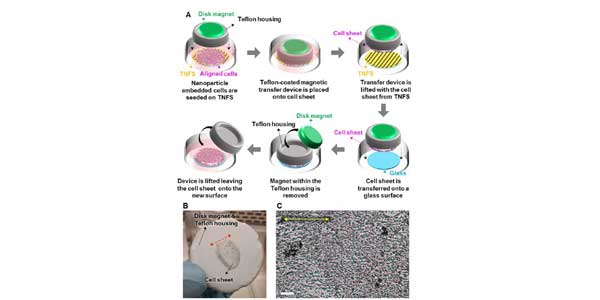Image: Cell sheet transfer using thermoresponsive nanofabricated substratum (TNFS) based cell sheet engineering technique and magnetic cell levitation.
In a recent paper published in Nanotechnology, UW Bioengineering Assistant Professor Deok-Ho Kim and colleagues describe a novel method for fabricating scaffold-free tissue-engineered constructs. The researchers’ methods were described in an article published on Nanotechweb.org.
The researchers first cultured mouse myoblast cells on thermoresponsive nanofabricated substrates (TNFS). The nanopatterned surface more closely replicates conditions found in vivo than commonly used tissue culture surfaces, such polystyrene tissue culture flasks.
Working with cultured cell sheets directly on TNFS has posed difficulty in the past, as competing mechanical forces of the culture surface and the work being done on the sheet compromised the sheet’s structural integrity. To address this challenge, the researchers electrostatically attached magnetic nanoparticles to the cell sheet. They paired the sheet with a disk-shaped magnet, which caused the sheet to lift off and levitate above the TNFS. Then, they were able to transfer the sheet to a new surface while keeping the characteristics defined by the TNFS intact. They were also able to employ this method to create a spherical cell structure using a ring shaped magnet.
The researchers envision that their method could be used to generate physiologically-relevant tissues for advancing study of tissue structure-function relationships, drug screening and regenerative medicine.



